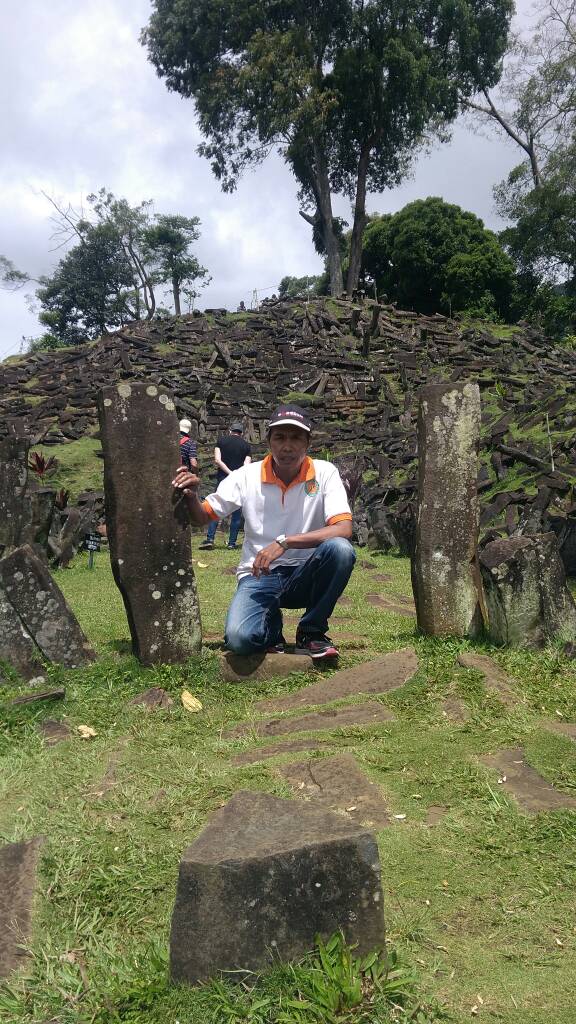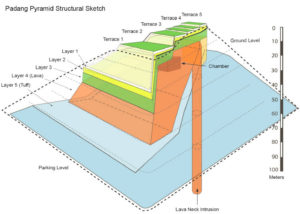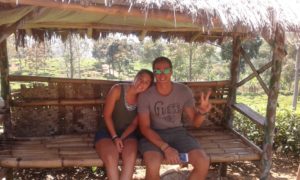
One of the most interesting things about Gunung Padang, aside from its age, is that during coring it was found that much of the buried structure was reinforced with a type of cement. This bonding agent, which has been used as a mortar and sort of glue in certain parts of the site, consists of 45% iron ore, 41% silica and 14% clay. It’s said that this mixture provides for a very strong and durable mortar base, and is surprising evidence of the level of sophistication of the building technique.
First described in the Dutch naturalist manual Rapporten van de Oudheidkundige Dienstin 1914, Gunung Padang had been known to locals for millennia. It sits on a hill in the Indonesian village of Karyamukti, which is in the Cianjur regency, in West Java province. It is described as the largest megalithic site in south-east Asia, and at first glance appears to be a series of terraces with bordering walls and successive steps between each. The terraces are covered in large volcanic rocks organised into lines and shapes, and the local Sundanese people declare the site to be sacred.
Early attempts to analyse the site resulted in dating of around 5000 BCE, which would put it in line with other sites in Asia and Europe. Radiometric dating and geoelectric testing done in 2012 seemed to confirm that date, though they found, quite surprisingly, that the site doesn’t actually sit on a hill. It is the hill.
Gunung Padang is a pyramid; one of the few pyramids found in south-east Asia. The site was found to have chambers and shafts hidden under the overgrown terraces with walled areas and other structures buried under centuries of natural reclamation. The next step in the excavation was to drill core samples in various locations to try to nail down a more accurate age for the site. This proved to be a dangerous endeavour for three tomography researchers who were beaten and kicked by locals who objected to the work, citing the sacred nature of the site.
Nonetheless, the work continued and the results were astounding.
Analysis of core samples of the hill and structure began to reveal greater and greater age the deeper they looked. From 5000 years, to 8000 years, to 10,000 years and all the way up to a reported 23,000 years old. These numbers are incredible! The implication is that this site is the oldest known structure of any kind on Earth.
“The results of radiometric analysis of the content of the carbon element in some samples of cement in drill core from the depth of 5-15 meters which was conducted in 2012 at the prestigious Laboratory, BETALAB, Miami, USA in the mid-2012 shows its age with a range between 13,000 and 23,000 years ago.”
Those results are contested, of course. Whenever data takes a drastic detour, one not expected by experimental guidelines, the first conclusion has to be that some mistake has been made. Experts on either side of the debate, however, are thus far unable to identify any problems in the coring procedures or in the radiometric dating that could account for such a drastic deviation from expected results. Currently the official age of the site is listed as “older than 5000 years”, which is maddeningly unhelpful, but research is continuing.
One of the most interesting things about Gunung Padang, aside from its age, is that during coring it was found that much of the buried structure was reinforced with a type of cement. This bonding agent, which has been used as a mortar and sort of glue in certain parts of the site, consists of 45% iron ore, 41% silica and 14% clay. It’s said that this mixture provides for a very strong and durable mortar base, and is surprising evidence of the level of sophistication of the building technique
It should come as no surprise that some have claimed this discovery in the name of ancient aliens, but the more interesting claim in that regard is in support of the One World Origin Theory.
Famed Fortean author Graham Hancock has proffered a hypothesis featuring Gunung Padang, wherein he suggests that this site may hold evidence of the lost city of Atlantis.
In a piece on Signs of the Times, Hancock tells of experiences he had with Danny Natawidjaja PhD., senior geologist of the Research Center for Geotechnology at the Indonesian Institute of Sciences. The two visited Gunung Padang and discussed the implications of these discoveries.
According to Natawidjaja, the site is indeed more than 22,000 years old.
“The geophysical evidence is unambiguous,”
Anyway, Gunung Padang is still rich of mystery and myth.
https://fb.watch/pbN9iD312M/?mibextid=Nif5oz
Please contact City Tour Jakarta for tour Gunung Padang
call or whatsapp +62 821 1243 8333
or mail to mail@citytourjakarta.com or reservasi3tour@yahoo.co.id


 0
0

